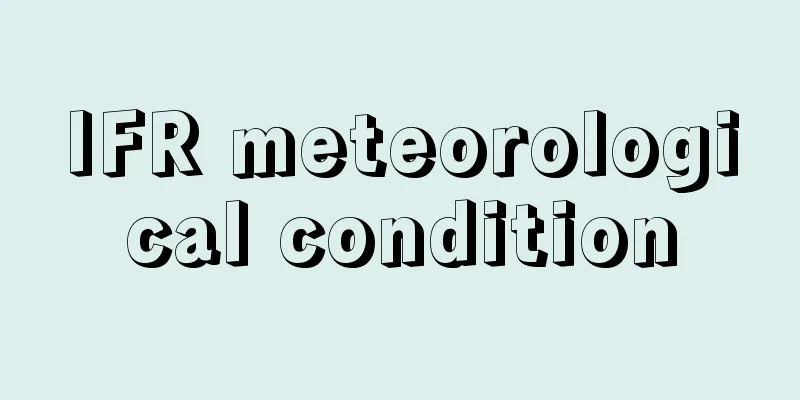Metamorphic rock

|
A rock whose texture and minerals have been partially or completely changed by metamorphism. When rocks are pushed deep underground due to crustal movements or intruded by igneous magma, the changes in temperature and pressure conditions cause reactions between the minerals that make up the existing rock, resulting in new minerals and textures that are different from those that were there before, and the properties of the rock change. The rocks formed in this way are called metamorphic rocks. [Mitsuo Hashimoto and Akihiro Murata] OccurrenceFrom a geological perspective, metamorphic rocks can be broadly divided into three types of origin. The first type is found in a relatively small area surrounding an intrusion of igneous rock. This occurs when the heat of the magma raises the temperature of the surrounding rocks, causing reactions between minerals to form metamorphic rocks. This type of occurrence is called contact metamorphic rock. The second type of occurrence is when it is not directly related to the intrusion of igneous rocks, but is distributed over a very wide area. This is because the temperature and pressure inside the Earth's crust changed significantly due to mountain building, and metamorphic rocks were formed over a wide area. Metamorphic rocks that show this type of distribution are called regional metamorphic rocks. The third type is when sedimentary or volcanic rocks were deposited in a very thick layer, and the lower part was exposed to a slightly higher temperature inside the Earth's crust, resulting in the formation of metamorphic rocks. This type of metamorphic rock is also widely distributed and is called buried metamorphic rock. [Mitsuo Hashimoto and Akihiro Murata] Chemical compositionDuring metamorphism, the chemical composition of a rock does not change substantially. Therefore, the chemical composition of metamorphic rocks is essentially the same as that of igneous and sedimentary rocks, and includes the following: (1) Mudstone and shale are rich in alumina Al2O3 and potassium K2O , but poor in lime CaO and magnesia MgO (magnesium oxide). Therefore, when they become metamorphic rocks, they produce minerals rich in alumina, such as muscovite, andalusite, kyanite, and sillimanite. (2) Sandstone metamorphic rocks and quartz-feldspathic metamorphic rocks Most sandstones are rich in quartz and feldspar. Therefore, they are rich in silica (SiO 2 ) but poor in iron (FeO) and magnesia. Acidic igneous rocks have similar chemical characteristics. (3) Basic metamorphic rocks Basalt and andesite are poor in silica and rich in iron, magnesia, and lime. When rocks of this composition are subjected to metamorphism, they produce minerals such as amphibole, epidote, and chlorite. (4) Calcareous Metamorphic Rocks The calcium carbonate in limestone, CaCO 3 , is almost always metamorphosed to calcite, but when limestone contains other elements, the metamorphism produces a variety of minerals, such as epidote, calcium garnet, diopside, and wollastonite. (5) Siliceous Metamorphic Rocks When rocks that are extremely rich in silica, such as chert, undergo metamorphism, metamorphic rocks consisting mostly of quartz are produced. Quartz schist is one such type of metamorphic rock. (6) Magnesian metamorphic rocks Peridotite and serpentine are rich in magnesia and poor in other elements. The metamorphic rocks derived from them contain chlorite, anthophyllite, tremolite, etc. [Mitsuo Hashimoto and Akihiro Murata] OrganizationMetamorphism occurs while rocks remain in a solid state. During metamorphism, rocks are often subjected to strong deformation. As a result, some metamorphic rocks retain the texture of the original igneous or sedimentary rocks, while others develop textures unique to metamorphic rocks that are not found in either igneous or sedimentary rocks. These include: (1) Schistosity In some metamorphic rocks, the large amounts of scale-like minerals (plate-like minerals) such as mica and chlorite are arranged with their bases parallel to one another, which gives the rock a tendency to break into parallel plates. This is called schistosity. Schistosity is often seen in regional metamorphic rocks that formed at relatively low temperatures, but it is not uncommon in contact metamorphic rocks. (2) Banded structure: Some metamorphic rocks have a structure in which parts of different mineral composition are repeatedly overlapped like stripes. Like schistosity, this is common in regional metamorphic rocks. Schistosity and banded structure often appear together, but it is not uncommon for schistosity to be present without banded structure, or vice versa. Rocks that have banded structure but weak schistosity do not necessarily split parallel to one another. (3) Massive structure: If metamorphism does not involve deformation of rocks, no directional structure is produced, and metamorphic rocks with a non-directional texture are formed. These are called massive. They are often seen in contact metamorphic rocks. (4) Porphyroblasts In metamorphic rocks, a few types of minerals grow significantly larger than the others and can look like igneous rock phenocrysts. These are called porphyroblasts. Garnet, cordierite, andalusite, and albinolite are prone to porphyroblasts. [Mitsuo Hashimoto and Akihiro Murata] kindsThe properties of metamorphic rocks are controlled by the chemical composition of the parent rock and the conditions of metamorphism. The same parent rock can become different metamorphic rocks under different conditions, and even under the same conditions, rocks with different chemical compositions can have different mineral compositions. Below are some of the main types of metamorphic rocks. (1) Slate and phyllite: Very fine-grained rocks with weak foliation due to slaty cleavage. These are muddy sedimentary rocks that have been subjected to regional metamorphism at relatively low temperatures. Many people include slate in sedimentary rocks, but this depends on the interests of the people, and there is no need to decide whether it is a metamorphic rock or a sedimentary rock. (2) Black schist: When the metamorphic recrystallization of mudstones progresses a little further, rocks with well-developed foliation and banding are produced. These rocks are rich in muscovite and chlorite, but contain graphite or carbonaceous matter with a lower degree of crystallinity, so they generally appear black, and are therefore called black schist. (3) Mica Schist If the temperature is even higher, black mica will replace the chlorite, and the metamorphic rock will be characterized by black mica and muscovite. This is called mica schist. (4) Greenschist When basic igneous rocks or pyroclastic rocks undergo regional metamorphism at relatively low temperatures, a strongly schistosified metamorphic rock characterized by green minerals such as chlorite, epidote, and actinolite is formed. This is greenschist. When the pressure is high relative to the temperature, high-pressure minerals such as glaucophanite and lawsonite are produced in green schist, turning it into glaucophane schist. Black schist, mica schist, and green schist are collectively called crystalline schist. (5) Amphibolite When basic igneous rocks are metamorphosed at a somewhat high temperature, amphibolite, which is composed mainly of plagioclase and hornblende, is formed. In addition to these two minerals, some also contain epidote as a main component, and are called epidote amphibolite. Amphibolite can be formed by regional metamorphism or contact metamorphism, but the latter produces massive amphibolite with no obvious foliation or banding. When calcareous sedimentary rocks and argillaceous sedimentary rocks are in contact with each other, a reaction between the two rocks can form an amphibolite-like rock, which is composed mainly of plagioclase and hornblende, at the boundary. Under high-pressure conditions, garnet can form in amphibolite, and it is called garnet amphibolite. (6) Gneiss When muddy or sandy sedimentary rocks are recrystallized under metamorphic conditions similar to those of amphibolite, they produce a somewhat coarse-grained rock with weak schistosity but a pronounced banded structure. This is gneiss, which has a composition similar to that of granite, consisting mainly of quartz, feldspar, and mica. However, gneiss is usually richer in alumina and iron than granite, and therefore often contains cordierite, garnet, sillimanite, etc. When plutonic rocks such as granite are subjected to regional metamorphism, and biotite and hornblende form roughly parallel arrangements, showing a structure similar to that of gneiss, this is sometimes called granite gneiss. (7) Granulite When the temperature of metamorphism becomes very high, all hydrous minerals such as mica and amphibole become unstable and decompose, resulting in coarse-grained metamorphic rocks consisting only of anhydrous minerals such as pyroxene, garnet, feldspar, and quartz. These are generally called granulites. Granulites have banded structures but little schistosity. In addition, quartz and feldspar in granulites are colored brown or dark blue, so even quartz-feldspar rocks often have a dark color. Granulites that do not contain any hydrous minerals are found almost exclusively in shields made of Precambrian rocks. (8) Eclogite A metamorphic rock that is thought to have been formed by metamorphic action of basaltic rocks under extremely high pressure and temperature. It is a relatively coarse-grained rock consisting only of garnet and clinopyroxene. It does not contain feldspar. Garnet is typically rich in magnesium and pyroxene is rich in sodium, but some eclogites are composed of garnets that are poor in magnesium and rich in iron, or pyroxenes that are poor in sodium and rich in calcium. It has almost no schistosity or banding. Another characteristic is its extremely high specific gravity. It occurs in block form in high-pressure, low-temperature metamorphic belts, as inclusion fragments in kimberlite, and as lenticular bodies in gneiss regions. (9) Hornfels: A dense rock with a massive structure without schistosity, formed by contact metamorphism. It contains biotite as its most common main component, and depending on the composition of the rock and the temperature of the metamorphism, it also contains andalusite, cordierite, orthopyroxene, sillimanite, corundum, etc. When basic igneous rocks are subjected to contact metamorphism, hornfels, which is composed mainly of plagioclase and hornblende, like amphibolite, is produced. This is a type of amphibolite, but it is called hornblende hornfels. (10) Marble and Skarn When limestone is subjected to contact metamorphism, a beautiful white rock consisting almost entirely of calcite is formed. This is called marble or crystalline limestone. Note that the term marble, used as a stone name, also includes non-metamorphosed limestone, so care should be taken. When limestone is mixed with small amounts of muddy sediments or material is injected from intrusive igneous rocks, a special rock consisting of various silicate minerals characterized by calcium is formed. This rock is composed of epidote, diopside, calcium garnet, wollastonite, anorthite, etc. and is called skarn. Skarn occurs as lenticular bodies in amphibolite and as the host rock of high-temperature metasomatic deposits. (11) Pyro-metamorphic rocks Xenoliths captured in volcanic lava can contain minerals that are stable at high temperatures and low pressures, unlike those found in ordinary metamorphic rocks, due to the extremely high temperature and low pressure of the lava (almost 1 atmosphere). For example, tridymite, mullite, and spinel. Such rocks are called pyrometamorphic rocks. Pyro means high temperature. In extreme cases, the rocks can partially melt and become glassy, with the remaining minerals floating in the glass. Of the above, slate, phyllite, and schist are metamorphic rocks formed at relatively low temperatures (200-300°C), while amphibolite and gneiss are formed at higher temperatures (400-600°C). Granulite is formed at even higher temperatures (over 700°C). Eclogite is formed under high pressure (over 10,000 atmospheres), while hornfels and pyrometamorphic rocks are formed under low pressure and without deformation. [Mitsuo Hashimoto and Akihiro Murata] MyloniteDuring fault movement deep underground, fine-grained, dense rocks are formed by ductile deformation. These are called mylonites. They are also called crushed rocks or mylonites. They are generally treated as fault rocks, but since they are formed at high temperatures deep underground and always involve metamorphism, they can be considered a type of metamorphic rock. Mylonites have planar structures parallel to the shear planes and line structures parallel to the shear direction. When mylonites are formed, minerals such as quartz are recrystallized and polycrystallized to become fine-grained rocks, but some minerals such as feldspars may escape the grain refinement and remain as large phenocryst-like particles (porphyroclasts). Such particles may show rotation due to shear. [Mitsuo Hashimoto and Akihiro Murata] MigmatiteIn areas where granite and gneiss are distributed in contact with each other, such as in Precambrian shields, it is often observed that the two are mixed together. In other words, granite veins are inserted into the gneiss in various shapes, and large and small chunks of metamorphic rock are incorporated into the granite, giving it a floating appearance, creating a heterogeneous overall state. This type of heterogeneous material is called migmatite. Therefore, migmatite is a word that refers to the state of occurrence rather than a type of rock. It is sometimes called hybrid rock, but this is not a type of rock either. [Mitsuo Hashimoto and Akihiro Murata] Shock metamorphic rocksWhen a meteorite hits the Earth's surface, extremely high temperatures and pressures are created in a very short time, causing minerals to appear in the impacted rocks that are formed under conditions that would not occur in the Earth's crust. Rocks containing such minerals are called shock metamorphic rocks, and are found around meteorite craters. Known minerals include high-pressure phases of silica such as coesite and stishovite, which form at pressures equivalent to depths of more than 100 kilometers underground, and amorphous silica glass such as lechatelyite. [Mitsuo Hashimoto and Akihiro Murata] "Metamorphic Rocks and Metamorphic Belts" by Miyakonojo Akiho (1966, Iwanami Shoten)" ▽ "Metamorphic Rocks of Japan" by Hashimoto Mitsuo (1987, Iwanami Shoten)" ▽ "Metamorphism" by Miyakonojo Akiho (1994, Iwanami Shoten)" ▽ "Iwanami Lecture Series on Earth and Planetary Sciences 9: Evolution of the Crust" by Taira Asahiko, Joken, Shikazono Naotake, Hiroi Yoshikuni, and Kimura Manabu (1997, Iwanami Shoten)" ▽ "Dynamics of Rock Formation" by Sakano Shohei, Toriumi Mitsuhiro, Obata Masaaki, and Nishiyama Tadao (2000, University of Tokyo Press)" [References] | | | | | | | | | | | | | | | | |Source: Shogakukan Encyclopedia Nipponica About Encyclopedia Nipponica Information | Legend |
|
変成作用によって、組織や鉱物の一部または全部が変化した岩石。地殻変動のため岩石が地下深くに押し込まれたり、火成岩マグマの貫入を受けると、温度・圧力条件の変化によって既存の岩石を構成する鉱物間に反応がおこり、それまでとは異なった新しい鉱物や組織が生じ、岩石の性質が変化する。このようにして生成した岩石が変成岩である。 [橋本光男・村田明広] 産状変成岩は、地質学的にみると、大別して三つの産出状態を示す。 第一は、火成岩の貫入岩体を取り囲んで、比較的狭い範囲に分布するもので、これはマグマの熱のため、周囲の岩石の温度が上昇し、鉱物間に反応がおこって変成岩を生じたものである。このような産状のものを接触変成岩という。 第二の産状は、火成岩の貫入などとは直接の関係がなく、非常に広大な地域にわたって分布する場合である。これは、造山運動に伴って地殻内部の温度や圧力が大規模に変化し、そのため広い範囲に変成岩が生成したもので、このような分布を示す変成岩を広域変成岩という。 第三は、堆積(たいせき)岩や火山岩が非常に厚く堆積したため、下部のほうが地殻内部のやや高い温度の下に置かれ、その結果変成岩となったと考えられる場合である。このような変成岩も広い分布を示し、埋没変成岩とよばれる。 [橋本光男・村田明広] 化学組成変成作用に際しては、岩石の化学組成は事実上変化しない。したがって、変成岩の化学組成は、火成岩や堆積岩のそれと基本的には同じで、次のようなものがある。 (1)泥質変成岩 泥岩や頁(けつ)岩はアルミナAl2O3やカリK2Oに富み、石灰CaOやマグネシアMgO(酸化マグネシウム)に乏しい。そのため変成岩になった場合、白雲母(しろうんも)、紅柱(こうちゅう)石、藍晶(らんしょう)石、珪線(けいせん)石などのように、アルミナに富む鉱物を生ずる。 (2)砂質変成岩、石英長石質変成岩 砂岩の多くは石英や長石に富む。したがって、シリカSiO2(二酸化ケイ素)に富む一方、鉄FeOやマグネシアに乏しい。酸性火成岩も化学的には似たような特徴をもつ。 (3)塩基性変成岩 玄武岩や安山岩はシリカに乏しく、鉄、マグネシア、石灰に富む。このような組成の岩石が変成作用を受けると、角閃(かくせん)石族の鉱物や緑簾(りょくれん)石、緑泥石などを生ずる。 (4)石灰質変成岩 石灰岩の炭酸カルシウムCaCO3は変成作用によって、ほとんどつねに方解石になる。しかし、石灰岩がそれ以外の成分を含むときには、変成作用の結果、緑簾石、カルシウムざくろ石、透輝石、珪灰石など、多様な鉱物を生ずる。 (5)珪質変成岩 チャートのようにシリカに著しく富む岩石が変成作用を受けると、ほとんど石英からなる変成岩が生ずる。石英片岩はこの種の変成岩である。 (6)苦土質変成岩 橄欖(かんらん)岩や蛇紋岩はマグネシアに富み、他の成分に乏しい。これらから導かれた変成岩は、緑泥石、直閃石、透閃石などを含む。 [橋本光男・村田明広] 組織変成作用は、岩石が固体の状態を保ったままでおこる。また、変成作用に際しては、しばしば強い変形作用が岩石に加わる。これらの結果、変成岩のあるものには、もとの火成岩や堆積岩の組織が保持され、一方、あるものには、火成岩にも堆積岩にもみられない、変成岩特有の組織が生ずる。それには次のようなものがある。 (1)片理(へんり) ある種の変成岩では、多量に含まれる雲母や緑泥石などの鱗片(りんぺん)状鉱物(板状鉱物)が、底面を平行にして配列しており、そのため岩石には平行な板状に割れやすい性質が生ずる。これを片理という。片理は比較的低温で生成した広域変成岩によくみられるが、接触変成岩にも珍しくはない。 (2)縞状構造(しまじょうこうぞう) 変成岩のなかで、鉱物組成の異なった部分が縞のように繰り返し重なった構造をもつものがある。これも片理と同じく広域変成岩に多い。片理と縞状構造とは伴って現れることが多いが、片理があって縞状構造のない場合も、その逆の場合も、ともにまれではない。縞状構造はあっても片理の弱い岩石は、かならずしも平行に割れない。 (3)塊状構造(かいじょうこうぞう) 変成作用に際して、岩石の変形を伴わない場合には、方向性の著しい構造は生じないで、いわば無方向性の組織をもった変成岩ができる。このようなものを塊状(マッシブ)であるという。接触変成岩によくみられる。 (4)斑状変晶(はんじょうへんしょう) 変成岩のなかで、ある少数の種類の鉱物だけが、他のものに比べて著しく大きく成長し、火成岩の斑晶のようにみえることがある。このようなものを斑状変晶という。ざくろ石、菫青(きんせい)石、紅柱石、曹長(そうちょう)石などは斑状変晶になりやすい。 [橋本光男・村田明広] 種類変成岩の性質は、原岩の化学組成と変成作用の条件とによって支配される。同じ原岩でも、異なった条件の下では、異なった変成岩になり、同じ条件下でも、化学組成の異なるものは異なった鉱物組成をもつ。以下にいくつかのおもな変成岩の種類をあげる。 (1)スレート(粘板岩)、千枚岩 きわめて細粒でスレート劈開(へきかい)から弱い片理をもつ岩石。 これらは泥質堆積岩が比較的低い温度で広域変成作用を受けたもの。スレートは堆積岩に含める人も多いが、それは人々の関心のあり方によるのであって、変成岩か堆積岩のどちらかに決めてしまう必要はない。 (2)黒色片岩 泥質堆積岩の変成再結晶作用がもうすこし進むと、片理も縞状構造もよく発達した岩石が生ずる。この岩石は白雲母や緑泥石に富むが、石墨(せきぼく)あるいはもうすこし結晶度の低い炭素質を含むため、一般には黒色にみえるので、黒色片岩とよばれる。 (3)雲母片岩 温度がさらに高い場合には、緑泥石にかわって黒(くろ)雲母が生じ、それと白雲母で特徴づけられる変成岩になる。これを雲母片岩という。 (4)緑色片岩 塩基性の火成岩や火山砕屑(さいせつ)岩が、比較的低い温度で広域変成作用を受けると、緑泥石、緑簾石、アクチノ閃石など、緑色の鉱物で特徴づけられる片理の強い変成岩ができる。これが緑色片岩である。温度に対して圧力が高い場合には、緑色片岩に藍閃(らんせん)石、ローソン石などの高圧鉱物が生じ、藍閃片岩になる。なお、黒色片岩、雲母片岩、緑色片岩などを総称して結晶片岩という。 (5)角閃岩 塩基性の火成岩が、やや高い温度で変成作用を受けると、斜長石と普通角閃石を主成分とする角閃岩ができる。この二つの鉱物のほかに、主成分として緑簾石をも含むものがあり、緑簾石角閃岩とよばれる。角閃岩は広域変成作用によっても、接触変成作用によってもできるが、後者の場合には片理も縞状構造も顕著でない、塊状の角閃岩を生ずる。石灰質の堆積岩と泥質の堆積岩とが互いに接しているとき、その境界部に両者の反応によって、同じように斜長石と普通角閃石を主成分とする角閃岩様の岩石ができることがある。高圧の条件下では、角閃岩にざくろ石を生ずることがあり、ざくろ石角閃岩とよばれる。 (6)片麻岩(へんまがん) 泥質や砂質の堆積岩が、角閃岩程度の変成条件下で再結晶すると、片理は弱いが縞状構造の顕著なやや粗粒の岩石を生ずる。これが片麻岩であり、石英、長石、雲母を主成分とする、花崗(かこう)岩に近い組成をもつ。もっとも、片麻岩は花崗岩よりはアルミナや鉄に富むのが普通で、そのためしばしば、菫青石、ざくろ石、珪線石などを含む。花崗岩などの深成岩が、広域変成作用を受けた結果、黒雲母や普通角閃石が粗い平行配列をとり、片麻岩に似た構造を示すようになったものを花崗片麻岩ということがある。 (7)グラニュライト 変成作用の温度が非常に高くなると、雲母や角閃石などの含水鉱物はすべて不安定となって分解し、輝石、ざくろ石、長石、石英などの無水鉱物のみからなる粗粒の変成岩ができる。このようなものを一般的にグラニュライトという。グラニュライトには縞状構造はあるが、片理はほとんどない。また、グラニュライトでは石英や長石が褐色あるいは暗青色に色づいて、そのため石英長石質のものでも、暗い色彩を呈することが多い。なお、含水鉱物をまったく含まないグラニュライトは、先カンブリア時代の岩石からなる楯状地(たてじょうち)にほとんど限られて産出する。 (8)エクロジャイト 玄武岩質の岩石が、きわめて高い圧力と温度の下で変成作用を受けたものと思われる変成岩で、ざくろ石と単斜輝石のみからなる比較的粗粒の岩石である。長石を含まない。ざくろ石はマグネシウムに富み、輝石はナトリウムに富むのが典型的であるが、マグネシウムに乏しく鉄に富むざくろ石や、ナトリウムに乏しくカルシウムに富む輝石からなるものもある。片理も縞状構造もほとんどない。比重がきわめて大きいことも特徴の一つ。高圧低温変成帯中にブロック状をなして産したり、キンバレー岩中の包有岩片としてもみいだされ、また片麻岩地帯にもレンズ状岩体として産することがある。 (9)ホルンフェルス 接触変成作用によって生成する、片理のない塊状組織で緻密(ちみつ)な岩石。黒雲母をもっとも普遍的な主成分として含むほか、岩石の組成や変成作用の温度の高低によって、紅柱石、菫青石、斜方輝石、珪線石、コランダムなどを伴う。塩基性火成岩が接触変成作用を受けると、角閃岩と同じように、斜長石と普通角閃石を主成分とするホルンフェルスを生ずる。これは角閃岩の一種だが、ホルンブレンド・ホルンフェルスとよばれる。 (10)大理石およびスカルン 石灰岩が接触変成作用を受けると、ほとんど方解石のみからなる純白粗粒の美しい岩石ができる。これを大理石あるいは晶質石灰岩(結晶質石灰岩)という。なお、石材名として使われる大理石には、非変成の石灰岩も含まれるので、注意を要する。石灰岩に若干の泥質堆積物が混入していたり、また貫入火成岩から物質が注入されたりする場合には、カルシウムで特徴づけられるいろいろな珪酸塩鉱物からなる特殊な岩石ができる。それは、緑簾石、透輝石、カルシウムざくろ石、珪灰石、灰長石などからなるもので、スカルンという。スカルンは角閃岩中のレンズ状岩体や、高温交代鉱床の母岩として産する。 (11)パイロ変成岩 火山の溶岩に取り込まれた捕獲岩片は、溶岩の非常に高い温度とほとんど1気圧という低い圧力とのために、普通の変成岩にはみられないような高温低圧で安定な鉱物を含むことがある。たとえば、鱗珪(りんけい)石やムル石、スピネルなどである。このような岩石をパイロ変成岩という。パイロpyroとは高温という意味である。極端な場合には、岩石は一部融解してガラス状となり、その中に溶け残った鉱物が浮遊した組織を示すようになる。 以上のうち、スレート、千枚岩、結晶片岩などは比較的低い温度(200~300℃)の下で生成した変成岩であり、角閃岩、片麻岩の生成温度はもっと高い(400~600℃)。さらに高い温度(700℃以上)ではグラニュライトができる。エクロジャイトは高い圧力(1万気圧以上)の下で生成し、ホルンフェルスやさらにパイロ変成岩は低い圧力と、変形作用の働かない条件下でつくられる。 [橋本光男・村田明広] マイロナイト地下深部における断層運動では、延性変形によって細粒で緻密な岩石が形成される。これをマイロナイトという。圧砕岩、ミロナイトとよばれることもある。一般的には断層岩として扱われるが、地下深部の高温下で形成され、かならず変成作用を伴うので、変成岩の一種と考えることができる。マイロナイト中には、剪断(せんだん)面に平行な面構造、剪断方向に平行な線構造が認められる。マイロナイトが形成されるとき、石英などの鉱物は、再結晶し多結晶化して細粒な岩石となるが、長石などの一部は、細粒化を免れて大きな斑晶状の粒子(ポーフィロクラスト)として残っていることがある。このような粒子には、剪断に伴う粒子の回転等が認められることがある。 [橋本光男・村田明広] ミグマタイト先カンブリア時代の楯状地などで、花崗岩と片麻岩が接して分布している地域では、しばしば両者が混合した部分が観察される。すなわち、片麻岩の中に花崗岩質の細脈がいろいろな形で入り込んだり、花崗岩の中に変成岩の大小の塊が取り込まれて、浮遊したようになり、全体として不均質な状態となっている。このような不均質なものをミグマタイトという。ミグマタイトはしたがって、岩石の種類というよりは、産出状態をいうことばである。混成岩ということもあるが、それも岩石の種類ではない。 [橋本光男・村田明広] 衝撃変成岩隕石(いんせき)が地表に衝突するときには、きわめて短時間の間に非常に高い温度と圧力とが実現し、そのため衝突された岩石には、地殻内では実現しないような条件でできる鉱物が出現する。そのような鉱物の生じた岩石を衝撃変成岩といい、これらは隕石孔の周囲にみいだされる。鉱物としては、地下100キロメートル以上の深さに相当する圧力で生じるコース石やスティショバイトなどのシリカの高圧相や、ルシャテリー石のような無定形シリカガラスなどが知られている。 [橋本光男・村田明広] 『都城秋穂著『変成岩と変成帯』(1966・岩波書店)』▽『橋本光男著『日本の変成岩』(1987・岩波書店)』▽『都城秋穂著『変成作用』(1994・岩波書店)』▽『平朝彦・徐垣・鹿園直建・広井美邦・木村学著『岩波講座地球惑星科学9 地殻の進化』(1997・岩波書店)』▽『坂野昇平・鳥海光弘・小畑正明・西山忠男著『岩石形成のダイナミクス』(2000・東京大学出版会)』 [参照項目] | | | | | | | | | | | | | | | | |出典 小学館 日本大百科全書(ニッポニカ)日本大百科全書(ニッポニカ)について 情報 | 凡例 |
<<: Transformer - henseiki (English spelling)
>>: Degeneration - Heterogeneity
Recommend
Law of exponents
(1) A law that applies to natural phenomena, in wh...
Gunmetal
〘 noun 〙 (named after its use in the manufacture o...
Orenburg (English spelling)
From 1938 to 1957, he was called Chkalov. It is th...
Thanjavur (English spelling)
An ancient city in central-eastern Tamil Nadu, sou...
Insurance medical care
Medical care provided under the medical insurance ...
Ifuyazaka
…The startled Izanagi evaded Izanami's pursui...
Royal Society
⇒Royal Society Source: About Shogakukan Digital Da...
Oicho Kabu
A type of gambling using stock cards, played mainl...
Pier Paolo Pasolini
Italian poet, novelist, and film director. After ...
Flatworm - Flatworm (English spelling)
A general term for flatworms belonging to the orde...
Hidaka Mountains
A steep mountain range that makes up the southern...
Hat - Hat
〘noun〙① Something worn on the head. (i) A general ...
Red frog - Red frog
A general term for frogs of the Ranidae family. In...
Shimazu Family Documents - Shimazuke Monjo
These are documents from the Middle Ages to the ea...
Adu - Adu
…The megaliths placed in front of each house are ...









